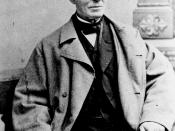Black slavery in the South created a bond among white Southerners and cast them in a common mold. Slavery was also the source of the South's large agricultural wealth, which led to white people controlling a large black minority. Slavery also caused white Southerners to realize what might happen to them should they not protect their own personal liberties, which ironically included the liberty to enslave African Americans. Because slavery was so embedded in Southern life and customs, white leadership reacted to attacks on slavery after 1830 with an ever more defiant defense of the institution, which reinforced a growing sense among white Southerners that their values eventually divided them from their fellow citizens in the Union. The South of 1860 was uniformly committed to a single cash crop, cotton. During its reign, however, regional differences emerged between the Lower South, where the linkage between cotton and slavery as strong, and the Upper South, where slavery was relatively less important and the economy more diversified.
Plantations were the leading economic institution in the Lower South. Planters were the most prestigious social group, and, though less than five percent of white families were in the planter class; they controlled more than forty percent of the slaves, cotton, and total agricultural wealth. Most had inherited or married into their wealth, but they could stay at the top of the South's class structure only by continuing to profit from slave labor. Planters had the best land. The ownership of twenty or more slaves enabled planters to use a gang system to do both routine and specialized agricultural work, and also permitted a regimented pace of work that would have been impossible to impose in free agricultural workers. Teams of field hands were supervised by white overseers and black drivers, slaves selected for...



Slavery
very well written essay explaining the black slavery history in the US and how the black suffered as a society.
4 out of 4 people found this comment useful.